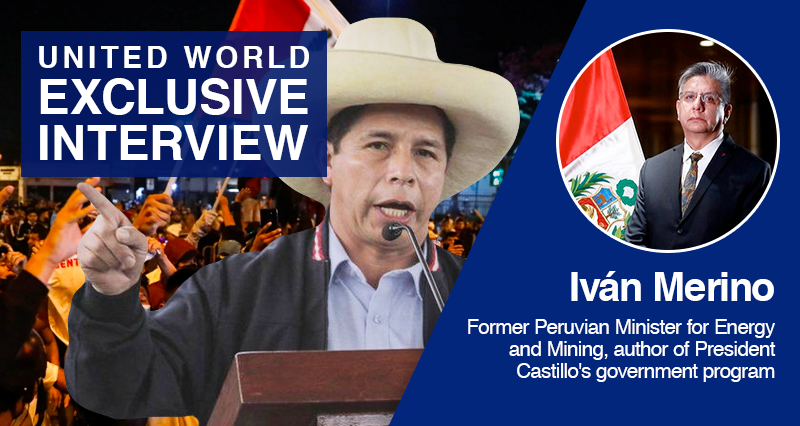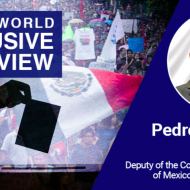By Fernando Esteche
In the last week, Peru has witnessed a change of presidency. President Pedro Castillo announced to dissolve the Congress, upon which the Congress itself substituted the President himself. While his Vice-President, Dina Boluarte assumed power. Castillo remains under custody being accused of corruption and coup d’etat, while thousands of Peruvians protest on the streets of the country for his immediate release and early elections.
United World International was able to interview Iván Merino. Merino is the author of the Bicentennial Project, the basis of President Castillo’s Government Program. He served as Minister of Energy and Mines in the Castillo government and wrote the speech with which Castillo assumed the presidency. Merino has been one of most important architects of Castillo’s electoral victory.
We spoke with him to help us understand how that victory was achieved and how the current situation emerged, where the president is removed, eliminating popular expectations.
How did the chance to build a popular government in Peru emerge?
By the end of the year 2020, the candidacies for the 2021 general elections had already been determined.
The traditional left, the social democracy, was configured around a female candidate (Verónica Mendoza) with a platform similar to that of Gabriel Boric in Chile. This platform was influenced by officials and experts from NGOs (non-governmental organizations), the majority of them financed by North American agencies and by organizations close to Soros.
How Castillo succeeded
The traditional communist parties, the PC Patria Roja, supported this candidacy with a fairly social democratic leadership; and also the Communist Party of Peru provided support. The latter has a very combative faction. But there is also has another faction in the party that dominates the CGTP (General Confederation of Labor of Peru). This faction is financed by a social democratic NGO and by the NED (National Endowment for Democracy). This group of traditional left formed an alternative and an electoral proposal.
The right focused its attacks mainly against the candidacy of that force, believing it to be the only progressive alternative with possibilities.
A provincial party (Perú Libre) made up of a doctor trained in Cuba (Vladimir Cerrón) sought alliances and met Pedro Castillo, who had come from serious confrontations with Patria Roja in the teachers’ union. He launched a candidacy with Castillo who, when accepting this proposal, adds to his group that they are teachers opposed to Patria Roja. It had some elements with combative tradition. And then, there were also people from the independent revolutionary anti-imperialist left.
When this proposal began its travels, it had no electoral numbers. In the middle of the campaign, a countryman told a leader of Peru Libre that this compañero, Pedro Castillo, was not “distinguishable” from others. Therefore, they put a countryman’s hat on him and there he was distinguishable with his hat.
It began with a very extensive territorial campaign and the elaboration of a government program according to the time without losing the line that was called the Bicentennial Plan, and also the (very revolutionary) Manifesto of Cajamarca; that was the electoral platform.
Castillo went to popular areas, the central zone, the jungle, the southern sierra and a process of popular identification with the candidate began.
To top it off, in Puno, in southern Peru, on the border with Bolivia, some policemen detained him and that was a point in favor of building prestige and growth.
The far-right approach attacked the social democrats. These had forwarded proposals to claim minorities such as gender and others and not so much socioeconomic ideas. This made the circumstances positive for us, because we were not attacked politically.
A lot of work was done in networks and on the territory, attacking above all the social democracy because the right already had its own space that was not disputed. We were growing in popular acceptance and there was a lot of identification with the teacher Castillo.
After the first round, new people we didn’t know came up and the Social Democrats also got involved with force.
There was a debate on technical teams and that was when Dina Boluarte, the vice president, appeared on the scene most decisively. She wanted to intervene in the entire campaign with her family group, whose two brothers are members of the centric Accion Popular party. Teacher Castillo surrounded himself with people who were quite questionable in terms of their methods and without a track record.
We tried to keep those people on the sidelines, which allowed us to create the Government Plan and to work better on the campaign that allowed us to win with the support of various left-wing parties.
In the proposal for the first cabinet, there was the intention to integrate all the parties of the left.
Why did they get so much electoral support?
There was the proposal for a more egalitarian education proposal. Before, there had been also scandals in the management of the pandemic and vaccination.
In Peru, health and education are clearly classist. Where the poor use the national system of education and public health, the rich and middle sectors use another system of social work or get treated prepaid.
There were also topics of defense of national sovereignty and national economy on our agenda.
Castillo began to put people from his environment who had never participated in the campaign, people from his province or his town, upstarts who had participated with right-wing groups at other times; he himself was a candidate for the Toledo group. (former neoliberal president of Peru).
Struggles in Castillo’s cabinet
A kind of negotiation was built where Castillo put up half of the cabinet and the left party space put up the other half.
The social democracy occupied two ministries (economy and women), other left-wing parties two more, and Peru Libre three ministries (prime minister, chancellery, and Energy and Mines).
Castillo’s friends stayed with the ministries with the most resources: Housing, Transportation and Communications. These have the biggest state investment. Dina Boluarte joined the Ministry of support for vulnerable populations (social inclusion). Defense and Interior were friends of Castillo.
The Chotano Group
Obviously all the scandals came from Castillo’s people. We didn’t know, but once elected, he had been co-opted by relatives and people from his place Chota. That’s why they are called the Chotanos group.
We knew that they were opportunistic but we thought that Castillo would not be so irresponsible to allow their voracity.
Can it be argued that these were elements that degenerated the project?
Yes, of course, of course!
We had thought about looking for an international position like the Third Way. We placed Héctor Béjar as chancellor to seek the autonomy from the gringos. Béjar had a very broad point of view. That’s how it started.
Did the operations to his replacement begin then?
The plan to remove him started from the moment of his election. Peru is an exclusive and divided country. It is a country more similar to Colombia or Chile than to Argentina or Brazil. In Peru there is a very clear cut along ethnicity, there is a white Western class in Lima and mestizo or original sectors in the provinces, with a lot of influence from the Catholic Church.
Seeking autonomy from the North Americans
You also talk about pressure from within the government…
We stated in the governmental program that all extractive and mining projects should give a social return. Their success should not only be measured in money but also in labor capacity, promotion of work, etc. But pressures from the Chotan environment began, pressing Héctor Béjar to resign and to realign foreign policy with the North Americans. They managed to remove Béjar and place a former minister from Toledo in his place, there is a first change and the Chotano environment begins to do business not only in their ministries but also in all areas. This was the first concession made to the Chotanos and to the right.
When they wanted to put a despicable character (Hugo Chávez Arévalo) at the head of PetroPeru and I refused. That cost me the induced resignation for them to seize PetroPeru, which is the most important state company. There a turn occurs that resumes the continuity of a political class taking advantage of the management of the state.
What was the reaction of the left?
There, certain sectors of the left offered to have a quota in ministries and tolerate all these things. In irrelevant ministries such as Environment and Health.
A group led by a very curious character named Guillermo Bermejo, formerly a leftist militant, gains prominence and begins to occupy the place of the left in the government.
A process of great degradation begins. More and more, new complaints emerge and cause ever-greater problems. The negotiated denunciations come from the Chotanos themselves fighting among themselves. As is the case of the former private secretary of Castillo and later Secretary General of the Presidency (Beder Camacho) who tries to go into exile with asylum, failing to do so, becomes a collaborator giving information on corruption and bribery to the prosecutor’s office.
The other general secretaries go through the same thing. The last straw was a businesswoman (Sada Goray Chong) confessing to paying a bribe of ten million dollars.
The judiciary of Peru is like in other countries colonized by Lawfare?
Yes, of course, yes. The judiciary receives courses from USAID and NGOs linked to the gringos.
If things had been done correctly, this judiciary, linked to what it is linked to, could not have made any progress.
Wrong policies towards the Armed Forces
What is the reaction of the popular sectors in front of all this?
The popular sectors are identified with Pedro, they feel he is one of their own, they think that the western right in Lima attacks him for being mestizo only.
Another mistake of Castillo was messing with the Armed Forces. Here the army has a popular component. The navy continues to be a traditional classist, but the army is more popular. It has been realized that the war with Shining Path was the country’s structural problem. It is not an army defending the status quo. It is an army that was itself in the process of change. It is an institution that was hit by the subjection act that Fujimori made them sign in the 1990s. So it is a hit army that was in the process of change.
What is Antauro Humala’s role in that?
Antauro has a predicament but you have to be careful with his surroundings.
Regarding the Armed Forces, Castillo begins to break internal logic and its rules and arbitrarily appoints generals and chiefs in key places, which deprives him of military support.
When he launched himself to make the blow, he did not calculate his own strength. The left in general remained silent.
How did Pedro Catillo fall into the self-coup trap?
The Chotano environment is the one that produces the induced error, among which is Bermejo, who I insist is a very rare character.
The popular sector in the south and central zone maintained mobilizations in favor of the president but there is no group that can unite them. They feel that it is a movement of the traditional Lima right.
The social democracy accused Castillo of being a traitor and a coup plotter, since his own man in the economy cabinet supported with his vote the entry of the character to PetroPerú.
People from the provinces of the Andean world and the Amazon know that the Lima group does not represent them.
There, Antauro Humala has capital that he can take advantage of. Antauro does not have a progressive speech. He is very particular. But when people ask for order and solution to their problems, Antauro could be a choice. People want clear rules and Antauro can offer that.
The social democracy could not ally itself with Antauro because of his policy that deplores issues of diversity and gender.
A certain sector of the most radical left would have no problem associating with Antauro if it does not get together with Chotano circles that are emerging sectors sometimes linked to drug trafficking and others.
The left is very out of place. Peru Libre could join Antauro. But Dina Boluarte wants to stay until the 26th without calling elections. And she does not speak of a change of Constitution.
What is you expectation?
It is probable that Boluarte continues living with the right. Dina’s place in the government is owed to the gender quota. This is how Dina appeared.
How should we interpret the immediate international support for Castillo’s removal?
Lula and the PT have a close relationship with Verónica Mendoza’s group and they read reality from there. And that group today rejects Castillo.









Leave a Reply